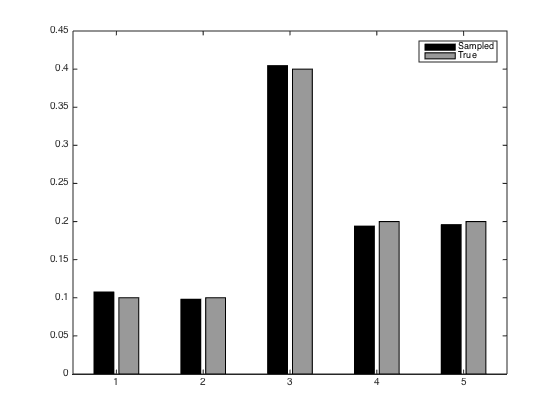Contents
state_chain.m
Sampling from the simple state space model as an example of MCMC Here we try a different proposal to make sure it still works!
From A First Course in Machine Learning Simon Rogers, August 2016 [simon.rogers@glasgow.ac.uk]
clear all; close all;
Define the transition probabilities
Each row defines the probabilities of going from a state Here we will make a random one
tran = rand(5,5); tran = tran./repmat(sum(tran,2),1,5);
Initialise some things
The initial state
x = 2; % The number of samples S = 2000; % The probabilities p = [0.1 0.1 0.4 0.2 0.2]; % A vector to store all sampled states allx = zeros(S,1);
Do the sampling
for s = 1:S % Propose new according to transition matrix newx = find(rand<=cumsum(tran(x,:)),1); met_ratio = p(newx)/p(x); % Proposal is no longer symmetric so we have to include the second term met_ratio = met_ratio * tran(newx,x)/tran(x,newx); if rand<=met_ratio x = newx; end allx(s) = x; end
Plot the resulting probabilities
figure(1);hold off [a,b] = hist(allx,1:5); a = a./S; c = bar([1:5],[a' p']); set(c(1),'facecolor',[0 0 0]) set(c(2),'facecolor',[0.6 0.6 0.6]) legend('Sampled','True')

Check detailed balance
The number of 1,2 in the sequence should be the same (roughly) as the number of 2,1
sum(allx(1:end-1)==1 & allx(2:end)==2)
sum(allx(1:end-1)==2 & allx(2:end)==1)
% Ditto 2,3 and 3,2
sum(allx(1:end-1)==2 & allx(2:end)==3)
sum(allx(1:end-1)==3 & allx(2:end)==2)
ans =
62
ans =
59
ans =
39
ans =
39